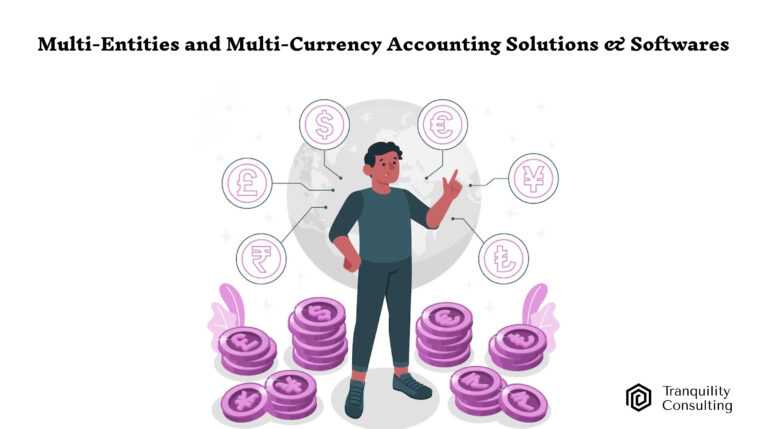In today’s globalized business environment, many companies operate across multiple regions, handling multi-entities and dealing with multi-currency accounting. This adds a level of complexity to financial management and compliance. Understanding multi-entity accounting processes and the intricacies of multi-currency transactions is critical to maintaining accuracy, efficiency, and compliance across the board. This blog will explore the challenges, strategies, and tools companies can leverage for multi-entities and multi-currency accounting, ensuring financial stability and operational efficiency.
What are Multi-Entity and Multi-Currency Accounting?
Multi-Entity Accounting
Multi-entity accounting involves the financial management of different legal entities or business units that could operate in other locations, countries, or regions. Each entity may have financial statements, operational requirements, and reporting needs. However, the parent company still needs a consolidated view of all entities for decision-making, tax filings, and regulatory compliance. Managing multi-entities can be complex due to different tax laws, regulations, and reporting standards that vary from one jurisdiction to another. The critical challenge for multi-entity accounting is consolidating financial data across these entities while ensuring accuracy and compliance with local laws.
Multi-Currency Accounting
Multi-currency accounting comes into play when an organization deals with different currencies across its entities or operations. Companies engaged in global trade often face transactions in multiple currencies, such as receiving payments in USD but incurring expenses in EUR or GBP. Multi-currency accounting systems are designed to handle foreign exchange (FX) rates, currency conversions, and exchange rate fluctuations, making it easier to record, track, and reconcile these transactions.
The Intersection of Multi-Entity and Multi-Currency Accounting
When you combine multi-entity and multi-currency accounting, the complexity multiplies. Companies must manage foreign currency transactions and comply with each entity’s financial reporting requirements across multiple countries. Consolidating financial reports, reconciling currency differences, and complying with local tax laws is time-consuming without suitable systems.
The Challenges of Multi-Entity and Multi-Currency Accounting
1. Consolidation of Financial Data
One of the biggest hurdles in multi-entity and multi-currency accounting is consolidating financial data from different entities. Each entity may operate in a different jurisdiction, have its chart of accounts, use different accounting systems, and report in another currency. Consolidating this information requires converting financial data into a common currency and ensuring that all data follows a consistent structure and complies with international and local accounting standards.
2. Currency Exchange Rate Fluctuations
Another significant challenge is managing currency exchange rate fluctuations. Exchange rates can change daily, affecting the value of foreign currency transactions, especially when reconciling accounts. Companies must decide whether to hedge against currency risks or absorb the losses caused by unfavorable exchange rate shifts.
3. Taxation and Compliance
Each entity in a multi-entity structure is subject to local tax laws and regulations, and often, these rules vary greatly. Companies dealing in multiple currencies also face different tax reporting rules for foreign exchange gains and losses. Keeping up with international tax regulations while ensuring compliance adds another layer of complexity.
4. Intercompany Transactions
In a multi-entity setup, intercompany transactions become inevitable. This includes transferring funds, allocating expenses, and sharing revenues among various entities. Managing intercompany eliminations, reconciling intercompany balances, and ensuring consistency in financial reporting can be a painstaking task without suitable systems.
Best Practices for Managing Multi-Entity and Multi-Currency Accounting
1. Implementing an ERP System with Multi-Currency and Multi-Entity Support
One of the best ways to streamline multi-entity and multi-currency accounting is using an Enterprise Resource Planning (ERP) system that supports both functions. Leading ERP systems like SAP, NetSuite, or Oracle have robust features to manage multiple entities, intercompany transactions, and foreign currency conversions. With a suitable ERP, you can automate much of the accounting process, reducing the manual workload and ensuring accuracy.
2. Real-Time Currency Conversion and Consolidation
Your system should be able to perform real-time currency conversions to manage multi-currency accounting efficiently. This helps minimize risks associated with exchange rate fluctuations. The ability to automatically update and adjust financial records according to the latest currency rates is essential for maintaining financial integrity.
3. Standardize Financial Processes Across Entities
Creating a consistent structure for all financial processes across your entities is critical. Standardizing charts of accounts, invoicing, and reporting methods helps streamline the consolidation process. This also ensures that your data is comparable across entities, making it easier to generate accurate financial reports for the entire organization.
4. Regular Audits and Reviews
Regular audits and financial reviews are essential given the complexity of managing multi-entities and multi-currency transactions. These help ensure that all entities remain compliant with local regulations and that financial reports accurately reflect the company’s overall performance.
5. Implementing Currency Hedging Strategies
To mitigate risks associated with currency fluctuations, many companies implement currency hedging strategies. This involves using financial instruments such as futures contracts, options, or swaps to lock in exchange rates for future transactions, thereby reducing the financial impact of unfavorable currency shifts.
6. Effective Tax Management
To stay compliant with international tax laws, companies should establish a tax management strategy that considers the unique requirements of each entity’s jurisdiction. This may involve working with local tax professionals or implementing tax software to handle multi-country tax compliance.
How to Choose the Right Multi-Entity and Multi-Currency Accounting Software
Choosing the right accounting software is critical to effectively managing multi-entities and multi-currency transactions. Here are some key factors to consider:
1. Scalability:
As your business expands, your accounting needs will evolve. Choosing a system that scales with your growth and accommodates new entities, currencies, and regulations is crucial. Look for software that can handle high transaction volumes and easily integrate with other financial tools.
2. Automation Features:
The right software should automate key processes, such as currency conversion, exchange rate updates, and financial consolidation. Automation reduces the risk of errors and saves time on manual entries and data processing.
3. Real-Time Reporting:
Generating real-time financial reports is essential for making informed decisions. Choose software that provides customizable reports, enabling you to track key metrics such as profitability, expenses, and revenue across different entities and currencies.
4. Compliance with International Standards:
Ensure your multi-entity accounting software complies with local and international accounting standards, such as GAAP or IFRS. This will ensure that your financial reporting remains compliant across jurisdictions and is ready for audits.
5. Integration with Existing Systems:
Your multi-entity accounting software should integrate seamlessly with existing systems like ERP, CRM, and tax management tools. This will ensure smooth data flow and reduce the need for manual data entry between systems.
Tools for Managing Multi-Entitay and Multi-Currency Accounting
- NetSuite ERP: A cloud-based ERP that supports multi-entity and multi-currency financial management, offering real-time reporting and automated consolidation.
- SAP S/4HANA: SAP provides robust support for multi-currency transactions and multi-entity accounting. It integrates seamlessly with global business operations and offers advanced features for foreign exchange management.
- Oracle Fusion: Oracle’s ERP system also supports multi-entity and multi-currency accounting, providing features like currency hedging, real-time currency conversions, and detailed financial reporting.
- Microsoft Dynamics 365: This platform offers end-to-end support for multi-entity and multi-currency accounting, making it easier for businesses to manage complex financial operations globally.
Conclusion
Handling multi-entity and multi-currency accounting is no easy feat, but with the right strategies and tools, companies can streamline their financial operations and ensure compliance. The key is implementing a robust ERP system, standardizing processes, and staying vigilant about currency management. By doing so, organizations can achieve operational efficiency, mitigate financial risks, and improve overall financial visibility. In today’s interconnected business world, mastering multi-entity and multi-currency accounting is crucial for any company looking to scale and succeed globally.
FAQs:
1. What is multi-entity accounting?
Multi-entity accounting involves managing financial data for different legal entities or business units, often across regions or countries.
2. Why is multi-currency accounting important?
Multi-currency accounting helps businesses manage transactions in multiple currencies, ensuring accurate currency conversions and compliance with exchange rates.
3. What challenges are faced in multi-entity and multi-currency accounting?
Key challenges include consolidating financial data, managing exchange rate fluctuations, handling intercompany transactions, and ensuring tax compliance.
4.How can ERP systems help with multi-entity and multi-currency accounting?
ERP systems like NetSuite and SAP automate currency conversions, consolidate financial data, and streamline processes, improving accuracy and efficiency.
5. What factors should companies consider when choosing accounting software for multi-entities and currencies?
Companies should consider scalability, automation, real-time reporting, compliance with international standards, and seamless integration with existing systems.
If you have any questions or need business-related tax consulting advice, please contact us at: [email protected]





